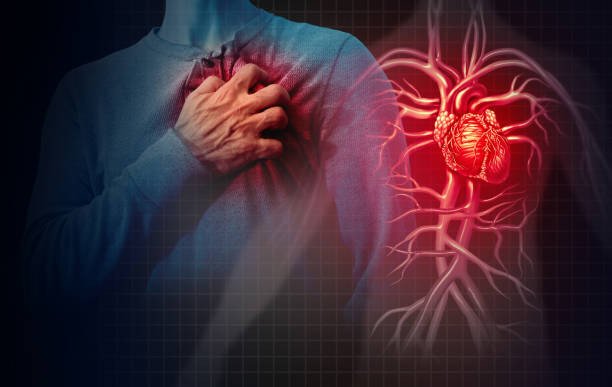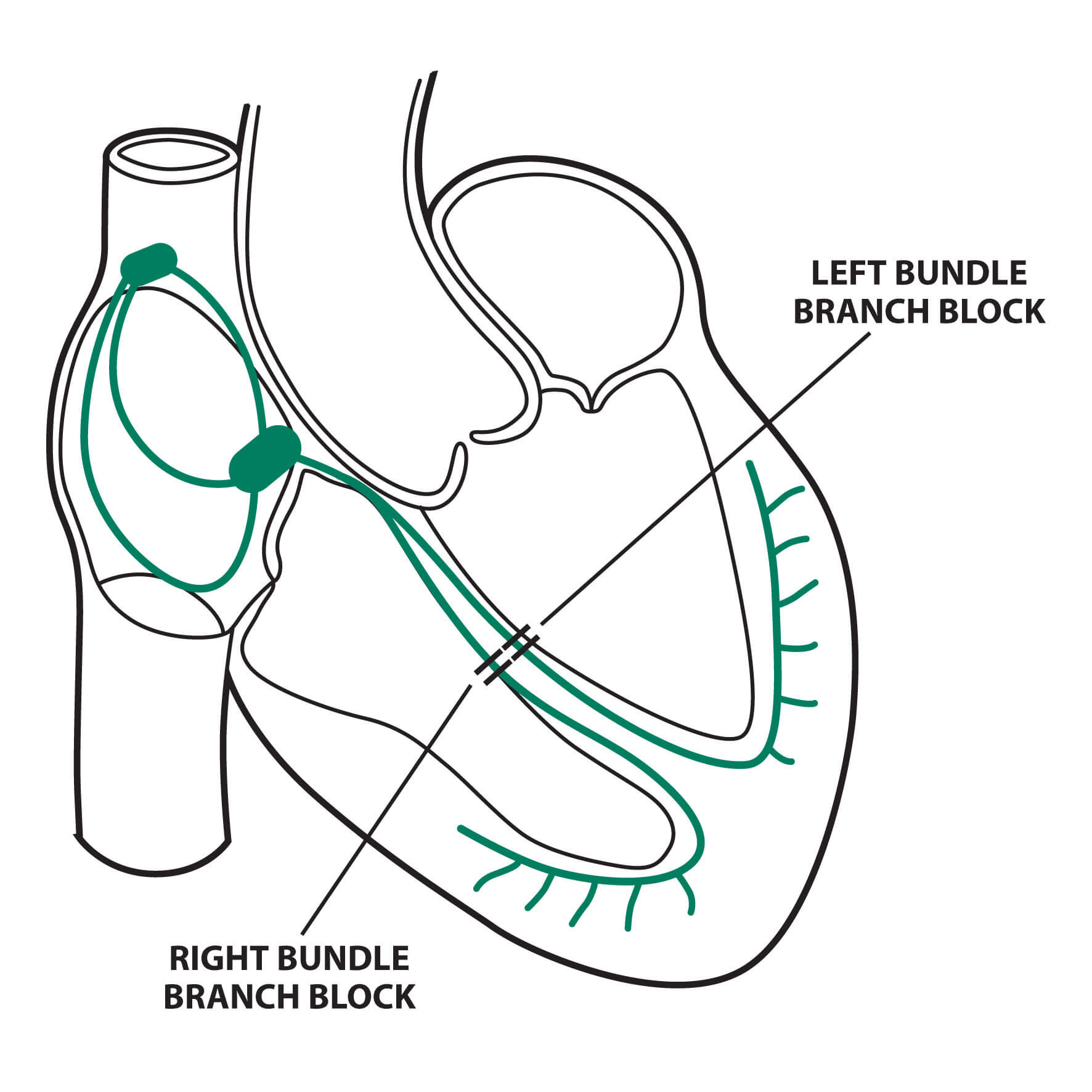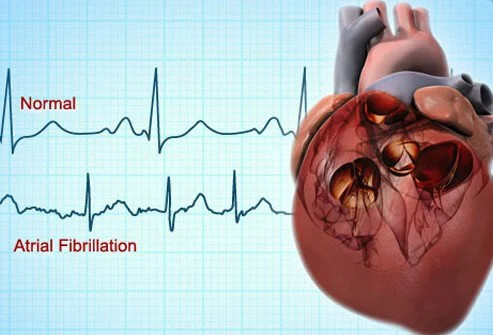Definition
Ventricular fibrillation is a form of heart rhythm disorder (arrhythmia). Ventricular fibrillation is an emergency that requires immediate medical attention. This arrhythmia is one of the leading causes of sudden death because it impairs the heart's ability to pump blood effectively.
Causes
The heart has four chambers: two atriums and two ventricles. The right atrium contains a group of cells known as the sinus node. The sinus node is a natural pacemaker. The sinus node generates the signal that starts each heartbeat. In a normal heart rhythm, the signal from the sinus node travels to both atriums. The signal then passes from the atriums to the ventricles via the atrioventricular (AV) node. This movement of signals causes the heart to contract, allowing it to pump blood to the lungs, heart muscles, and the rest of the body.
Ventricular fibrillation occurs when the electrical current in the muscles of the ventricles flows abnormally. For example, in a myocardial infarction (heart attack), the cells surrounding the muscle under attack can cause an electrical discharge, disrupting the existing electrical flow. Furthermore, when electricity is supposed to flow in one direction, it returns to the previous direction, a process known as circuit reentry. These then cause the ventricles to be unable to contract effectively to pump blood around the body.
Risk factor
Factors that increase the risk of ventricular fibrillation include:
- Previous episodes of ventricular fibrillation
- History of heart attack
- Congenital heart defects
- Disease of the heart muscle (cardiomyopathy)
- Injuries that damage the heart muscle, such as being struck by lightning
- Substance abuse, especially cocaine and methamphetamine
- Electrolyte imbalances (substances that regulate fluid balance in the body), especially potassium and magnesium
Symptoms
The most common symptom of ventricular fibrillation is fainting or sudden loss of consciousness. Before ventricular fibrillation occurs, there are some signs and symptoms to look out for:
- Chest pain
- A very fast heart rate (tachycardia), usually above 100 beats/minute
- Dizziness
- Nausea
- Shortness of breath
When ventricular fibrillation occurs, a person becomes unconscious, unable to respond to stimuli, and has no palpable pulse. If not helped immediately, death can occur within minutes.
Diagnosis
Ventricular fibrillation can be detected by electrocardiography (ECG). If a patient is experiencing cardiac arrest, doctors will administer advanced life support in an attempt to restore the patient's heart rhythm. Oxygen, IVs, and monitors will be placed. On the monitor, one of the waves that may be detected is ventricular fibrillation. Several tests will be performed by the healthcare professional to try to restore normal heart rhythm, including:
- Electrolyte levels in the blood, including calcium and magnesium
- Heart enzymes, such as creatine kinase, myoglobin, and troponin
- Complete blood test to look for anemia (lack of blood)
- Blood gas tests to look for acidosis (too high levels of acid in the blood) or hypoxemia (lack of oxygen in the blood)
- Toxicology or drug screening, e.g. quinidine, procainamide, tricyclic antidepressants, and digoxin, as well as substances such as cocaine and methamphetamine
- Thyroid hormone screening to detect thyroid problems that trigger an excessively fast heart rate, which can lead to heart failure over time
- B-type natriuretic peptide (BNP)
These examinations are designed to look for potential causes of ventricular fibrillation. If the patient is stable, imaging tests such as chest X-rays and echocardiograms can be performed. A chest X-ray can be used to look for heart failure and enlarged heart chambers. Meanwhile, echocardiography examines the heart using sound waves (ultrasound) to look at the heart's work in pumping blood as well as any parts of the heart muscle that are not contracting properly.
Management
Ventricular fibrillation is an emergency condition that must be treated immediately. Initial management will be done according to the Advanced Cardiovascular Life Support (ACLS) protocol:
- Cardiopulmonary resuscitation (CPR) is an attempt to compress the chest and pump blood from the heart to the rest of the body. The CPR performed on the patient must be of high quality so that it can simulate the natural heart pump
- Heart shock devices. This is useful if the patient is experiencing ventricular fibrillation. It delivers high-energy electricity to stop the heart's electrical flow so that a new normal flow can be established
These efforts continue while securing the airway with a breathing tube, correcting electrolyte levels, giving fluids via IV, treating pneumothorax (free air in the chest cavity that can compress the lungs and heart), and draining fluid in the case of tamponade (fluid collects in the lining of the heart, preventing the heart from pumping blood properly). If the electricity and heart rate have returned to normal, the doctor will address the underlying cause of ventricular fibrillation.
Medications that can be used to prevent further arrhythmias may also be prescribed. In addition, the doctor may also consider implanting a cardiac shock device to treat cardiac arrest quickly.
Complications
If not treated quickly, ventricular fibrillation can cause death within minutes. The rapid and irregular flow of electricity in the heart can cause it to abruptly stop pumping blood throughout the body. In this condition, blood pressure drops suddenly and drastically. The longer the body is without blood, the greater the risk of damage to the brain and other organs.
Ventricular fibrillation is one of the leading causes of death from cardiac arrest. The risk of other long-term complications largely depends on how quickly you get the appropriate help.
Prevention
Prevention of ventricular fibrillation is possible if there is known prior heart disease. If there are other signs of heart rhythm abnormalities, detection using ECG and implantable monitors will go a long way in preventing cardiac arrest due to ventricular fibrillation. If you have a family history of sudden death or previous arrhythmia syndromes, you can get genetic testing and counseling to reduce your risk of arrhythmia.
When to see a doctor?
If you believe your heart rate is constantly fast without a clear cause, see a doctor, particularly an internist or heart specialist. If you find someone who suddenly faints, seek immediate medical attention.
- dr Nadia Opmalina
Goyal, S. (2018). Ventricular Fibrillation: Background, Pathophysiology, Etiology. Retrieved 11 April 2022, from https://emedicine.medscape.com/article/158712-overview
Ludhwani, D., Goyal, A., & Jagtap, M. (2021). Ventricular Fibrillation. Retrieved 11 April 2022, from https://www.ncbi.nlm.nih.gov/books/NBK537120/
Ventricular fibrillation - Symptoms and causes. (2021). Retrieved 11 April 2022, from https://www.mayoclinic.org/diseases-conditions/ventricular-fibrillation/symptoms-causes/syc-20364523












